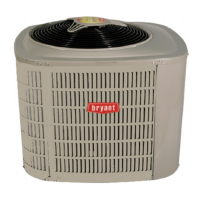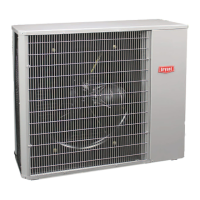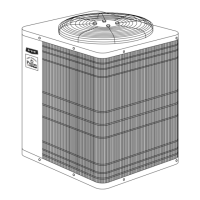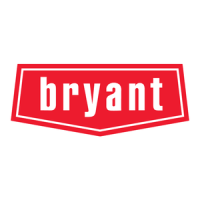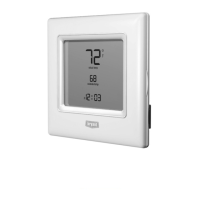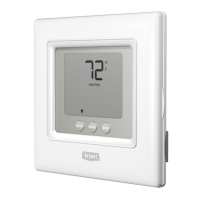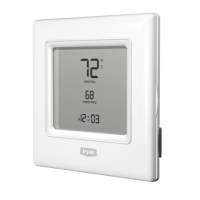22
COMPRESSORS
Lubrication
Compressors are charged with the correct amount of oil at the
factory.
Replacing the Compressor
The compressor using Puron
®
refrigerant contains a POE oil. This
oil has a high affinity for moisture. Do not remove the compres-
sor’s tube plugs until ready to insert the unit suction and discharge
tube line ends.
NOTE: Only factory-trained service technicians should remove
and replace compressor units.
COMPRESSOR MOUNTING BOLTS
Compressor mounting bolts should be periodically inspected for
proper tightness. Bolts should be tightened and have the torque set
at 65 to 75 in.-lb (7.3 to 8.5 Nm).
COMPRESSOR ROTATION
On 3-phase units with scroll compressors, it is important to be cer-
tain compressor is rotating in the proper direction. To determine
whether the compressor is rotating in the proper direction:
1. Connect service gages to suction and discharge pressure
fittings.
2. Energize the compressor.
3. The suction pressure should drop and the discharge pres-
sure should rise, as is normal on any start-up.
NOTE: If the suction pressure does not drop and the discharge
pressure does not rise to normal levels.
4. Note that the evaporator fan is probably also rotating in
the wrong direction.
5. Turn off power to the unit. Use applicable lockout/tag-out
procedures.
6. Reverse any two of the unit power leads.
7. Reapply power to the compressor.
The suction and discharge pressure levels should now move to
their normal start-up levels.
NOTE: When the compressor is rotating in the wrong direction,
the unit makes an elevated level of noise and does not provide
cooling.
Filter Drier
Replace the filter drier whenever refrigerant system is exposed to
atmosphere. Only use factory specified liquid-line filter driers
with working pressures no less than 650 psig (4482 kPa). Do not
install a suction-line filter drier in a liquid line. A liquid-line filter
drier is designed for use with Puron (R-410A) refrigerant and is
required on every unit.
REPLACING THE FILTER DRIER
Use the following steps to replace the filter drier.
1. Using Puron (R-410A) gage set, recover all refrigerant
from system.
2. Use tubing cutter to remove filter drier from line.
NOTE: Do not use a torch to remove old filter drier. The heat from
the torch will allow contaminants into the air and into the open re-
frigeration system.
3. Sweat a new replacement filter drier into refrigerant line.
4. Re-charge refrigerant system.
Adjusting the Condenser-Fan
1. Shut off unit power supply. Apply appropriate lockout/tag-
out procedures.
2. Remove condenser-fan assembly (grille, motor, and fan).
3. Loosen fan hub setscrews.
4. Adjust fan height as shown in Fig. 25.
5. Tighten setscrews to 84 in.-lb (9.5 Nm).
6. Replace condenser-fan assembly.
Fig. 25 — Condenser Fan Adjustment
TROUBLESHOOTING COOLING SYSTEM
Troubleshooting Cooling System
Refer to Table 5 for Troubleshooting Cooling System topics.
WARNING
FIRE, EXPLOSION HAZARD
Failure to follow this warning could result in death, serious
personal injury and/or property damage.
Never use air or gases containing oxygen for leak testing or for
operating refrigerant compressors. Pressurized mixtures of air
or gases containing oxygen can lead to an explosion.
WARNING
PERSONAL INJURY AND ENVIRONMENTAL
HAZARD
Failure to follow this warning could cause personal injury or
death.
Relieve pressure and recover all refrigerant before system re-
pair or final unit disposal.
Wear safety glasses and gloves when handling refrigerants.
Keep torches and other ignition sources away from refriger-
ants and oils.
WARNING
FIRE, EXPLOSION HAZARD
Failure to follow this warning could result in death, serious
personal injury and/or property damage.
Never use non-certified refrigerants in this product. Non-certi-
fied refrigerants could contain contaminates that could lead to
unsafe operating conditions. Use ONLY refrigerants that con-
form to AHRI Standard 700.
CAUTION
UNIT DAMAGE HAZARD
Failure to follow this caution may result in damage to compo-
nents.
The compressor is in a R-410A refrigerant system and uses a
polyolester (POE) oil. This oil is extremely hygroscopic,
meaning it absorbs water readily. POE oils can absorb
15 times as much water as other oils designed for HCFC and
CFC refrigerants. Avoid exposure of the oil to the atmosphere.

